|
|
|
|
|
| -- Baltic Sea from A to... Å -- |
| |
|
|
| No sooner landed than we are back to
our other life: the parallel universe of civil life. We get back to our
house, our dry and ironed shirts, and our jobs. As if nothing had
happened, almost as if we had never left. And yet, when talking with
our colleagues, it becomes clear that after four months exploring every
nook and cranny of the Baltic Sea, we almost know it from A to Z, or
rather from A to ... Å!
|
|
|

Saltimbanque sailed 3345 NM during this trip
|
|
|
|
|
|
| |
|
|
|
|
Archipelago: see Skjærgård
|
|
|
| Beacons:
The channels of the Finnish and Swedish archipelagos are admirably
marked. Finland claims more than 20% of the sea beacons
worldwide! Navigation – at least by day - is very easy. However,
lighthouses are limited to the few channels used by commercial traffic,
and sailing at night between the rocks is almost impossible.
Fortunately, it's only dark from August to April ...
|
| Birds:
Our feathered friends were omnipresent during this trip: the usual
seagulls of course, but also an impressive population of cormorants and
more confidential species of penguins-related birds: guillemots, razor
bills ... But in these brackish waters we also meet many swans, ducks,
geese, herons, egrets and eiders. On-shore we find swallows by the
dozen, and even by the hundred every night in Bornholm as they gather
in a huge and noisy cloud. And let’s not forget birds of prey,
sea-eagles, quite common in the North of the area (they seem to prefer
the large beacons along populous channels to nest). | 
A small sample of the various birds we met during this trip. Can you identify them ?
|

We still love picking up our food in the nature
| Blueberries: They
cover the undergrowth from Finland to Sweden. On the smallest crumb of
land large enough to house some pines, you are sure to find blueberries
at their feet. And there are many, small crumbs of land, in this
region! For sure our diet was very reinforced with vitamin C in July!
Bring: 1. A "bærplukke" (it is a rake mounted on a plastic tray - on
sale in almost all stores) and 2. Covering clothes, even a mosquito net
over your face... yes, they are well guarded!
|
| Boat: What
kind of boat for such a journey? Distances are rather short, harbours and
anchorages often tiny, water sometimes shallow and channels always
narrow: for us, a small boat with a shallow draft is ideal for sailing
in the Baltic Sea. Even for Saltimbanque many anchorages were
inaccessible, especially in western Finland. | 
The very official guest harbour of Bergö in Northern Finland, one of
the few ones up there being - just - large and deep enough for
Saltimbanque
|

Evening walk on the seawalls of Christiansø
| Bornholm: Gorgeous
stopover on the island of Bornholm, and particularly the charming port
of Allinge, with its fish smokehouses and yellow dwellings. Christiansø
is also not to be missed - weather permitting. |
|
|
|
Budget:
Extremely dependent on the country. In former Eastern Europe life is
cheap, but the marinas in Latvia and Estonia are very expensive (20 to
25 euros for a boat of 8m50) Once in the Nordic countries, everything
gets very costly, but the physiognomy of the shore line allows for
anchoring almost everywhere and thus saving mooring fees.
The cheapest country is probably Poland, then Russia, and the most expensive Denmark
because it is hardly possible to anchor there, unlike Sweden and
Finland.
All in all, we spent on average 1500 euros per month for the 2 of us (that is 50% more than for our trip around the Atlantic).
|
Charts: We
are changing our minds about paper charts. We have not found paper charts to copy for this trip and brand-new sets of charts are
really expensive (45 to 100 euros depending on the perimeter covered)
and sometimes very challenging to find (as in Estonia). Finally, we
bought a few large-scale paper charts, allowing us to plot our course
for the longer crossings, and then used the Norwegian phone application
"gulesider" for the detailed ones. All the rocks are not always shown
on the digital charts, anchorages must always be approached carefully.
Note that in these non-tidal waters, the depths are given for an
average and not minimal water level! The water level can easily change
by plus or minus 50 cm, and even more than 1m with deep low-pressure
systems. To be kept in mind when approaching shallow channels.
|
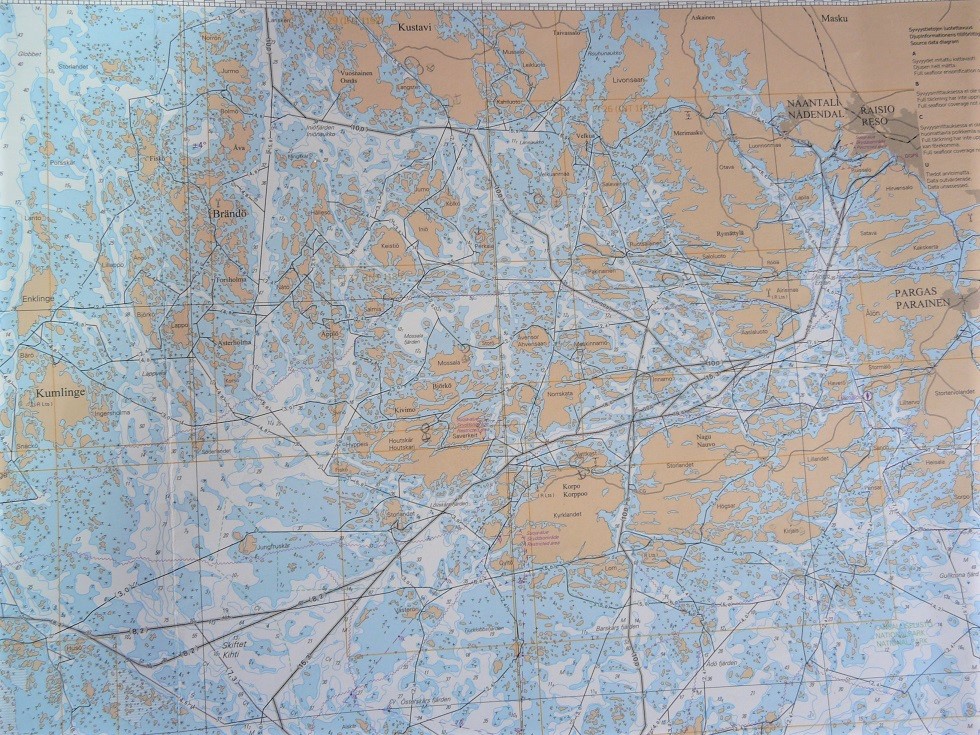
Large-scale chart of the Turku archipelago, detail charts are compulsory whatever the format!
|
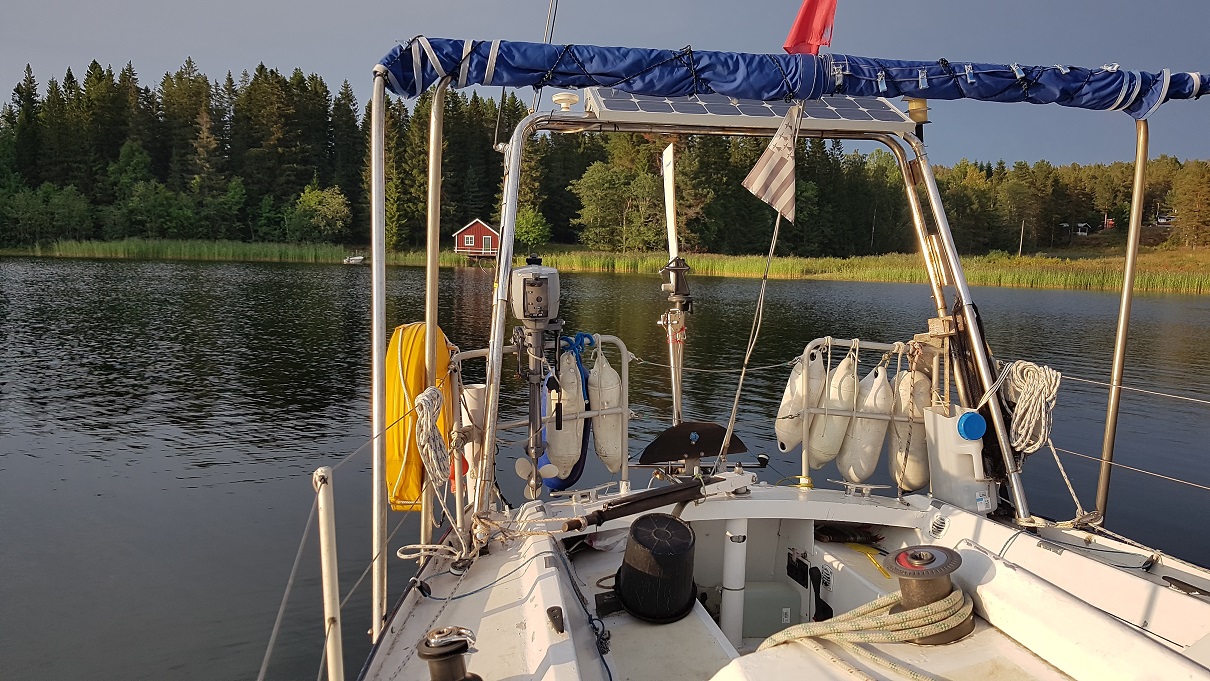
On
this picture, two important devices that are always out and ready in
Northern Baltic: the stern anchor and... the insect swat ! (Tennviken,
Sweden, 63°N)
| Equipment: We
left as for a summer holidays, without Iridium or special equipment,
the VHF and Internet being enough to receive the forecasts in this
area. The only addition to our inventory already quite complete since
the trip around the Atlantic: a kerosene heater, very useful to warm
and dry the cabin. We only used it in September, but we had exceptional
weather conditions. One should bring clothes for all types of
weather, from cold and wet to hot temperatures!
We still do not have an AIS, it is not essential, but we easily imagine
the advantages of a transducer, so cargo ships can see us and our boat
friends can see onto which island we are anchored!
Speaking of which, we recommend having two anchors ready onboard: a
heavier one at the bow, and a lighter one at the stern, with a little
chain (10m max) and strap on a reel. It is essential in all the ports
of eastern Sweden, and for rock mooring (sometimes in combination with
pitons to hammer yourself in the rock)
Apart from that Saltimbanque is doing very well! We had almost no
problem during this trip: only a small leak in the engine exhaust pipe
quickly repaired and a worn-out cog in a winch that we will have to
replace.
|
| Estonia: The
nice surprise of this trip! We had no idea what to expect and we really
liked this small dynamic country, taking in hand its tormented destiny
and with rather beautiful landscapes. Cruising there is still
confidential, but the infrastructures are put in place quickly, it is
really time to enjoy it before it gets crowded! Now we would like to go
back there during winter to try ice-sailing… | 
View onto the really nice medieval town of Tallinn, capital city of Estonia
|
Firing zones: The
Cold War may be over, tensions are still present, and the armies of the
various neighbouring countries are keeping in shape. Especially Poland,
Russia and Lithuania who regularly organize military exercises in
well-defined firing zones. During such exercises these firing danger
areas are closed to all navigation, not convenient when it applies to
the whole of the Kaliningrad maritime territory for example. It is
imperative to check for planned exercises before departing ... (see our
links page)
|

Perches, the only fresh water fishes we managed to catch
| Fishing: After
a few seasons in the Skagerrak fishing huge mackerels in less than 10
minutes of trawling, and even cod just from the pontoons, we were full
of hope for the Baltic Sea. What a disappointment! The sea is brackish
to fresh, and trawling gives nothing. Fishing from any pontoon neither.
In general, we have not seen much sea life in the Baltic Sea. There are
no professional fishermen, fish traps nor crab pots (except in Poland),
it's a sign ...
Only perches are easy enough to fish for beginners like us, they
generally gather under structures like pontoons or reeds. The fishing
is done with a bait (shrimp, cheese, overdue sausages ...), a float and
a good pair of eyes: it is necessary to put the bait under the nose of
the fish to have a chance to catch it.
In Finland you need a license to fish with a reel, but you can easily
find static telescopic rods. In the marinas popular for families on
vacation, the pontoons are teeming with kids with their miniature rods
and bucket. It's a sign that there, it bites.
In Sweden spearfishing harpoons are considered weapons and totally forbidden.
|
Fresh water: Once East of the Danish islands, the sea water is
barely salty, and even becomes completely fresh deep in the gulfs of
Gdansk, Riga, Finland and Bothnia. When the first surprise is passed
over, we enjoy certain advantages: clothes actually dry out, the soap
works, the water removes grease from the dishes better, the hull stays clean and
the motor gets perfectly rinsed. Two drawbacks however: the boat floats
a little lower on the water, and when we find water in the bilge, it’s
tricky to determine its origin by tasting it! Fresh water may come from
rain, condensation, a tank leakage, or a more critical water entry. On
the other hand, salt water in the bilge can come only from the rain or
waves which rinsed the sails and ropes in the cockpit locker before
flowing in!
|
Gas: While
in Western Europe butane gas from CampingGaz is commonly used, Northern
Europe is all about propane and has a wide variety of different bottles. Two
solutions then: either having enough gas to be fully autonomous
(which we chose, by refueling our CampingGaz bottles in Copenhagen in
May), or changing the system and regulator whenever necessary. Last
resort, re-filling empty gas bottles at the nearest gas station (rarely
exactly that close ...)
Germans: They were nowhere to be seen around the Atlantic, but
we finally found where the German boaters were hiding: they represent
90% of the Baltic Sea voyage boats. Along with a very few Dutch,
Russians, English, rare Belgians. Surprisingly hardly any Norwegians.
No French.
|
Höga Kusten:
The Swedish High Coast, one of our favourite stopovers. The islands are
indeed higher, the channels deeper, and we had the same weather
conditions as in the Canary Islands 7 years ago, it helps enjoying the
place! Better to have some SEK in cash as the only way to pay for the
harbours is often dropping a bill or two in a mailbox…
| 
The High Coast is indeed slightly higher than the surroundings
|

Clouds of midges on the beach of Fäliskäret, Northern Finland
|
Insects:
The sub-Arctic regions are famous for their mosquitoes in summer. It's
not a legend! They are huge and attack mostly at night, and in the
forest at any time of the day. We were happy to have mosquito nets
already made for all portholes!
But more than mosquitoes, it is mostly the horseflies that really
bothered us: it was just impossible to walk in the forest without
having 4 or 5 or more around us. Sometimes they attacked us even on the
boat, especially in Finland. Their bite is painful, for a long time.
However, the only real health threat comes from ticks. Some islands,
even small, are infested, and they can transmit when biting Lyme
disease or Tick Born Encephalitis. To our experience they bite during
the night following the exposition and we always thoroughly checked
ourselves the day following our hikes. We were lucky and probably had
not been bitten, having spotted and been able to expel on time the two
ticks which tried climbing on us.
|
Itinerary: Our
trip consisted of two separate parts. First from Oslo to Saint
Petersburg, discovering new countries and cultures, visiting sumptuous
cities in a somewhat unknown and new environment. The former capital of
the Russian Empire was the climax of this first phase. Then, in Finland
and Sweden, we move away from the cities and sail in unspoiled nature,
dropping the anchor in moorings all cuter than the others.
We are delighted with our choice, even though we lacked time to visit
the very end of the Gulf of Bothnia or spend more time in Gotland. A
crew not so found of history and culture may consider skipping the Southern shores and going straight to
Bornholm, Öland and Gotland before heading to Estonia, Finland, Åland,
and then sailing back via the Göta Canal through Sweden and out to
Gothenburg. This gives more time to enjoy all the fantastic small
anchorages.
|

The rocks are sometimes so vertical that we can come and stay alongide. Here in the Turku archipelago we still had 6m of water.
| Mooring techniques: These
non-tidal waters allow for experimenting various mooring techniques.
Each country has its preferred method: finger berths in Norway, mooring
piles in Denmark, dangling lines in Russia, stern buoy and bow to the
quay in Finland, stern anchor and bow to the quay in East Sweden.
But the most exotic berths are definitively found in Dziwnow (Poland):
beautiful wide and brand new catways but with angled at a 45° and
therefore … it is forbidden to walk on them! You have to climb off the
bow to get onshore!
At the anchorage, it is of course always possible to drop the anchor
from the bow, classic. But the vast majority of locals prefers to use
their stern anchor and moor the bow of the boat on-shore, on available
bolts, trees, or even their own bolts to be hammered in cracks in the
rock. The Swedes (but apparently they are the only ones), tend to even
moor alongside the rocks. Not advisable in the Channel...
|
Motoring: We
motored for more than 200 hours during this trip (including motoring in and out of ports),
probably about as much as during our 15 months around the Atlantic.
Blame it on our mega-high that made the weather generally good and calm
for two months and a half.
We really enjoyed having a brand-new engine. Changing the power cables
this winter was also THE good idea. The engine has always started like
a charm and propelled us without hiccups at about 4 knots. So that
after a few weeks, with increased confidence, we integrated the
possibility of motoring to establish our navigation plan. We who
previously refused to leave in a flat calm, added the Diesel breeze
option to our set of kills. And that's how we end up with 200 hours
motoring at the end...
| 
A super flat calm between Latvia and Estonia
|

A selection of the hundreds of litres of plastic we picked up during this trip
| Plastics: During
this trip we were always keeping a trash bag in our back-pocket, ready
to collect the various plastic waste that littered our itineraries. We
picked up plastics mostly on the shore line, a bit in the forest and we
had decided not to clean the cities. In 4 months we have collected more
than 275 Litres of plastic, the winner prize of the most polluted
coastline being awarded to Poland.
The waste we have collected can be classified into 3 main categories:
- Candy or snack wrapping, especially crisp bags and lollipop sticks.
- Water bottles and beer or soda cans
- Fishing gears, less common but large-sized waste
A local specificity: the Russians are fans of inflatable balloons that unfortunately generally finish their lives in the sea…
|
Rhythm: There
is a lot to see in the Baltic Sea and we completed this trip at a fast
pace. The crossings are never very long (at most 330 miles from Poland
in Latvia), so for us it was rather a succession of sprints: no need to
manage one’s fatigue when we leave for no more than 24 hours, let’s
enjoy spinnaker at night and long hours of manual steering. Once
onshore, no time to waste, let’s go visiting! So that after 4 months on
this regime we were a bit tired ...
And yet we only sailed 3345 NM in total, that is 836 NM per month
average. But for comparison, in 3 months of sailing in the West Indies
we had covered only 1265 NM, or 421 NM per month: twice slower. It
looks like we are the only boat who visited both St. Petersburg and the
Gulf of Bothnia over this year’s season, and we have met only one boat
(a beautiful aluminium German) who had sailed further North than us
this year, to the very end of the Gulf of Bothnia.
Most boats only sail by day, rarely by night. Which works quite well in
this perimeter: except in Russian and Lithuanian waters, there are
ports every 30 NM or so (this is even the name of the Finnish-Estonian
coastal development program).
| 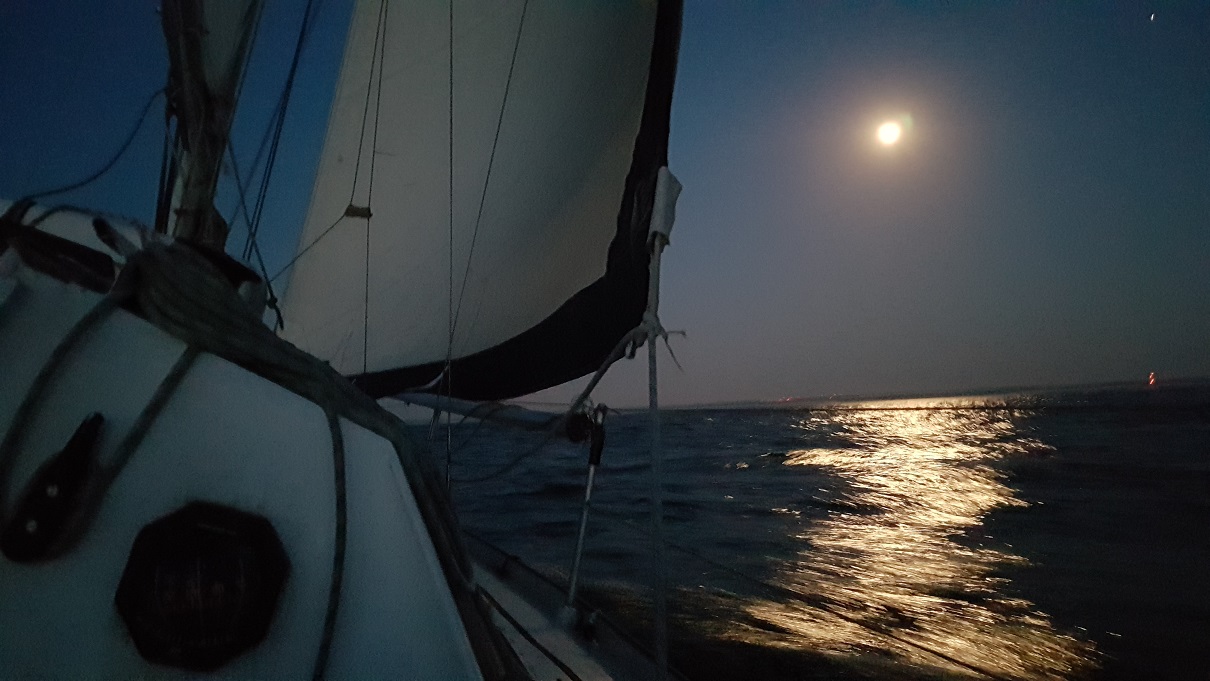
First
it's not dark for long, plus with such fantastic moonlights it would be
a shame not to enjoy sailing by night ! (offshore Poland)
|
Season: North is beautiful, but
the season is short... We left mid-May, barely 10 days after our boat
was back to the water after a long and cold winter, and the frequent
gales of early September very clearly encouraged us to get back home
quickly. To our opinion, it is difficult to consider sailing longer
than the 4 summer months (mid-May to mid-September) in the Baltic Sea.
To have time to enjoy it serenely, the ideal is probably to take two
seasons with wintering in Helsinki or Stockholm.
But a memorable voyage over a single season is definitively possible,
even from France or England, with a departure in April and a return in
September / October. The route from the Channel to and from the Baltic
Sea can be made at 80% in protected waters, through the Dutch inland
waters and then the Kiel Canal!
|
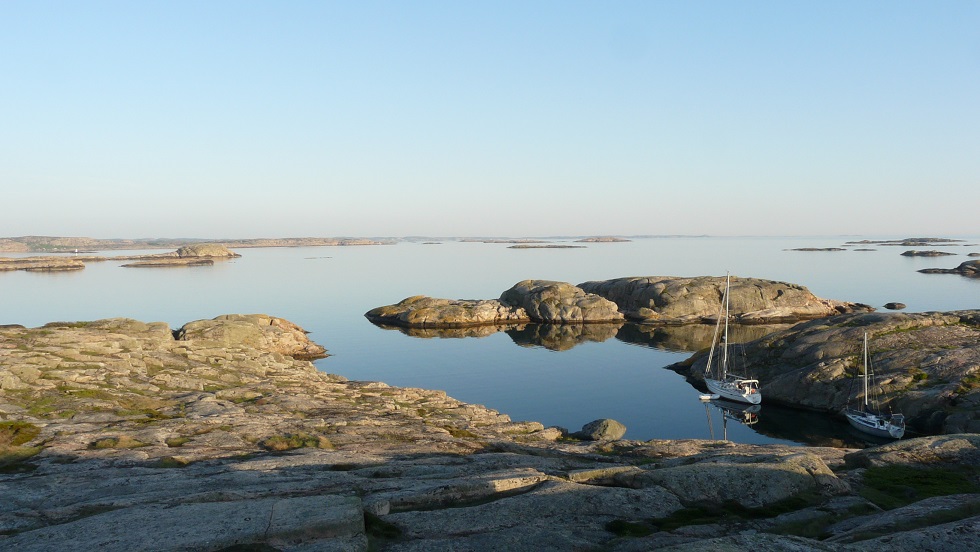
Rock mooring at the heart of the Bohuslän skjærgård, Western Sweden
| Skjærgård in
Norwegian, skärgård in Swedish, saaristo in Finnish : a word that could
be roughly translated by archipelago, but which is more about a group
of skerries than a group of islands. The locals hardly ever leave it,
and know by heart these protected waters, extremely well marked for day
sailing (much less by night, but it never gets dark in July during the
summer season), with endless possibilities of anchorages and shelters.
Neither land nor sea, the skjærgård is both at once, it's a world
apart. Untranslatable concept, you have to come and experience it to
fully understand!
|
| St-Petersburg: The
former capital of the Russian Empire is definitely worth a visit.
Getting there by boat combines adventure with tourism. The procedure is
a bit heavy: once the visa is obtained, you must officially leave the
European Union in Finland or Estonia, then sail for a hundred nautical
miles along the commercial traffic before entering Russia. But if all
paperwork is in order, then it’s only about enjoying the golden
churches and wonderful palaces, the museums and the canals, the
pelmenis and the kvass!
| 
The
Neva, the winter palace, the dome of St-Isaac church, the spire of the
Admiralty, seen from the St-Peter & St-Paul fortress: in a word,
St-Petersburg...
|
Weather : We had an absolutely
odd weather this year. A high-pressure system established itself in
mid-April and only let go in early August. Sometimes calm weather
indeed, but two and a half months of sunshine and temperatures worthy
of the Mediterranean. August and September were more normal according
to locals.
To our experience, the weather changes rapidly in the Baltic Sea. The
local weather forecasts, especially the Swedish one that covers almost
the entire area, is very accurate at 48h, less in the longer term. The
sea is always extremely short, with regular trains of 3 successive
waves higher than the others. It picks up very quickly but also calms
down very quickly. Still sailing close hauled in these conditions can
be very painful. Between the southern tip of Sweden and Germany, we
have been each time surprised by the height of the waves compared to
the strength of the wind.
|
Åland
and the Turku archipelago: A myriad of islets and skerries that
continues Finland for about 200km. You can sail days without ever
seeing the pure horizon line of an open sea. The anchorage
possibilities are endless, it's the ultimate skjærgård experience ...
Åland is besides a real bridge between Sweden and Finland: Finnish
territory but Swedish speaking population, it is an independent region,
with a deeply rooted maritime culture.
| 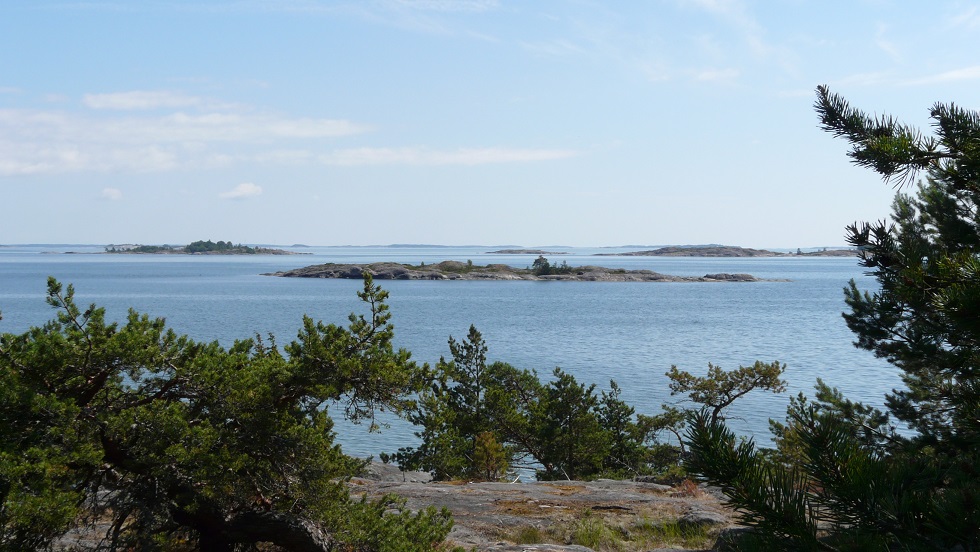
This area of the Turku archipelago is not very dense, still there are rocks and islands as far as the eye can see
|
We
prepared this trip like extended summer holidays, a breath of fresh air
from our life onshore. Like a welcomed break between our trip around
the Atlantic 6 years ago, and the next "real" long-distance voyage
which is slowly but surely taking shape.
It was a bit unfair to this Sea. It deserves the journey, it
deserves the dream. These waters, unknown and distant to whom grows
up in Western or Southern Europe, are home to centuries of interwoven
history, memories of boats of all kind and shapes, and an amazing mix
of eclectic landscapes.
The Baltic is a world apart, a very much closed basin connected only
drop by drop to the open seas. The temperate conditions allow
to enjoy a largely preserved nature, and to alternate at will
between pleasant large Nordic cities and the maze of tens of thousands
of islets and as many possibilities of anchorage. The Baltic Sea is a
human-sized, welcoming sea with astonishing sheltered "skjærgård"... to
be enjoyed intensely during the few summer months!
|
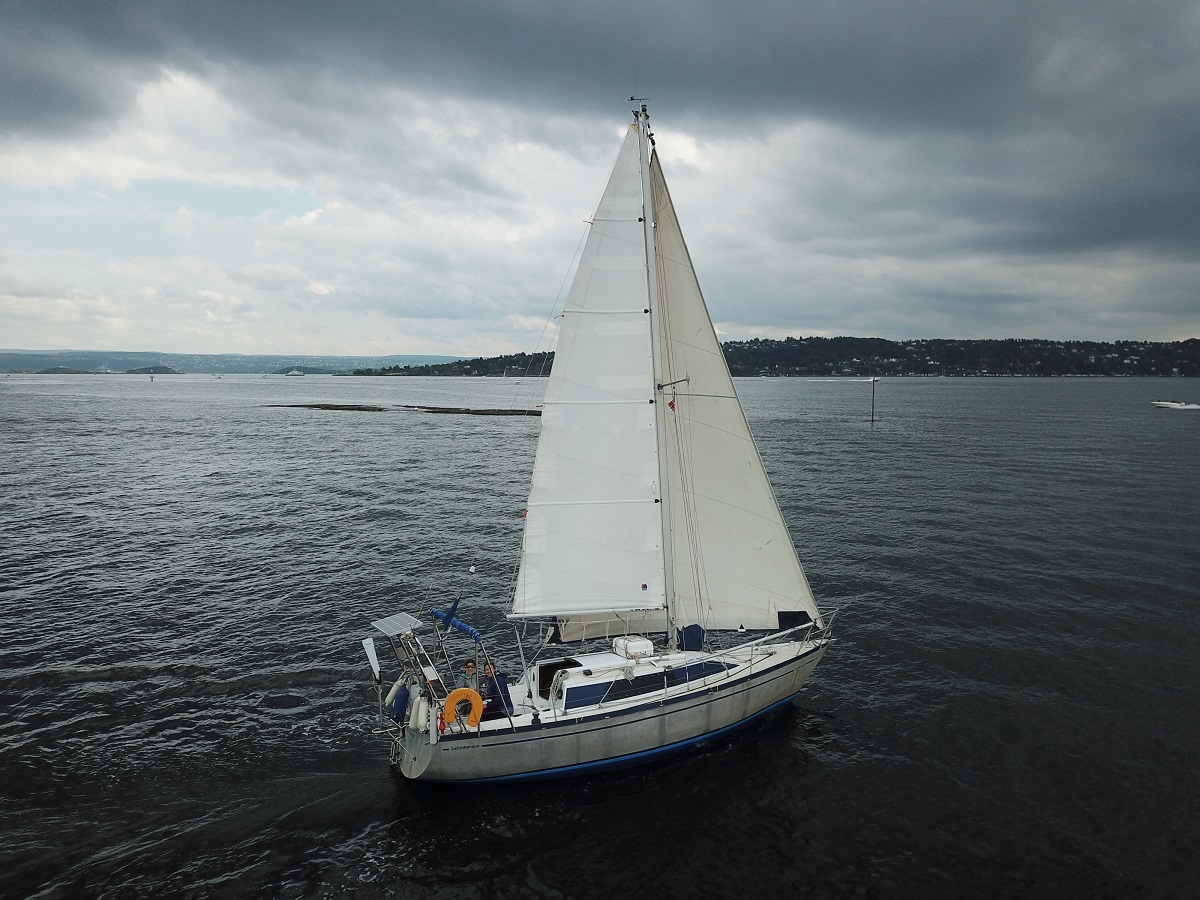
See you soon for more adventures !!
|
|
|
|
|
|
|
|
| |
| |
| |
| TOP
|
| |
| |
| |
| |
|










